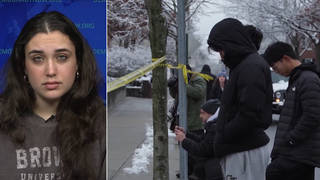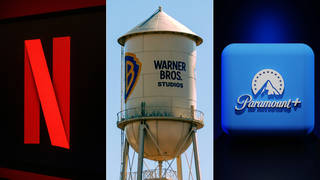
Hannah Sassaman of the Prometheus Radio Project joins us to talk about a series of developments that could result in the creation of hundreds, if not thousands, of new noncommercial radio stations. Legislation has been introduced that would allow the FCC to grant more licenses to low-power FM stations. Meanwhile, the FCC is opening the door for new noncommercial and education full-power radio stations. [includes rush transcript]
Transcript
AMY GOODMAN: As concern over media consolidation intensifies, a series of developments have occurred in Washington that could result in the creation of hundreds, if not thousands, of new noncommercial radio stations. On Thursday, Congressmembers Mike Doyle and Lee Terry introduced the Local Community Radio Act of 2007 to allow the FCC to grant more licenses to low-power FM stations. A similar bill is being introduced in the Senate. Meanwhile, the FCC is opening the door for new noncommercial and education full-power radio stations. The FCC has announced there will be a week-long window beginning in mid-October for applications to be filed.
To talk more about these developments, Hannah Sassaman joins us here in the firehouse studio. She’s the program director of Prometheus Radio Project. Welcome.
HANNAH SASSAMAN: Thank you so much.
AMY GOODMAN: So explain this bill.
HANNAH SASSAMAN: Well, it’s really exciting. And listening to the headlines that you just read just now, it really makes me think how many communities out there, especially urban communities, don’t have their own news, aren’t able to communicate the diverse information that happens in their communities. Senators John McCain and Maria Cantwell, as well as Congressmembers Mike Doyle and Lee Terry — so these are bipartisan teams — just introduced the Local Community Radio Act of 2007. What this bill will do, if passed, is it will let the FCC grant hundreds, if not thousands of new community radio stations in urban areas.
When the FCC established the low-power FM radio service, low-power FM, groups in cities like New Orleans, Minneapolis, Albuquerque, San Francisco, would have been able to have their own community radio stations. One fantastic group, the Hmong Community Art Center in Minneapolis, was raring to go. They were about to build their station, but because the National Association of Broadcasters, which is the large lobbying agency that represents Clear Channel, Cumulus, ABC, all the big broadcasters, worked together with NPR to convince Congress that low-power FM, if you built these community stations — 100 watts — in big cities would interfere with large stations of 50,000 watts or higher. So Congress limited low-power FM to towns like Opelousas, Louisiana, rather than New Orleans, and Oroville, California, rather than San Francisco.
These bills would reverse that ban, taking into account essential research conducted by the FCC that proves there’s plenty of room for these stations. Now is the time when we have to act to let thousands of communities have their own community radio.
AMY GOODMAN: How do people find out about it? How do people apply to get a community radio station?
HANNAH SASSAMAN: After Congress — well, first of all, Congress needs to get these bills passed. And there are thousands of community members and many, many strong organizations, everyone from the Christian Coalition to Free Press to the Future of Music Coalition to Consumers Union and many, many other groups, are letting people know that these bills are on the table. Once these bills are passed, the FCC will announce a licensing window, when any noncommercial group, whether you’re a community church, a department of transportation, a chamber of commerce or a school, you can talk to the FCC, fill out your form and get a free license, in order to serve your community with essential information.
One of the stories I really like to tell is of WQRZ-LP in Bay St. Louis, Mississippi. When Hurricane Katrina made landfall at ground zero, basically, in Waveland and in Bay St. Louis in Hancock County, of the 41 stations lining the Mississippi and Louisiana Gulf Coast, only a handful stayed on the air, and WQRZ-LP, this low-power noncommercial station, was one of them. When this station was broadcasting about the storm, local volunteers swam across the floodwaters with batteries strapped to their back to keep the station on the air. It was the only source of local information for 48 hours after the storm, and because it was so essential, the Emergency Operations Center of Hancock County set up shop with that station and became the FEMA headquarters, and it got a commendation from the president.
These stations not only save lives, but are deeply relevant to their communities. If you’re a farmworker community and you speak Zapotec and Quiche as your primary languages and Spanish as a second language, you can’t rely on Clear Channel, Viacom or Infinity for your news. In order to connect to your community, to organize for rights in the fields, you need your own community radio station, like Radio Consciencia of WCTI-LP in Immokalee, Florida, the Coalition of Immokalee Workers’ station. These stations are tools for social justice, and if we don’t take this chance to build them now, we’ll never forgive ourselves when we turn around in 20 years and hear the same corporate drivel and the same Christian right radio that we now have to abide by in our big cities and our small communities.
AMY GOODMAN: Do you have to be a nonprofit?
HANNAH SASSAMAN: You have to be a nonprofit, and up ’til now you had to live in a very rural area, because the National Association of Broadcasters said that low-power FM stations interfered in big cities, because there was too much on the dial, but the FCC got the MITRE Corporation, an independent contracting firm, to conduct a comprehensive $2.2 million listening study with our taxpayer dollars, and it proved beyond the shadow of a doubt that your local nonprofits, the Thomas Merton Peace and Justice Center in Pittsburgh, places like that, should be able to apply for their own stations. This is a really exciting day for community radio.
AMY GOODMAN: And then you have a window opening up in October for full-power FM radio stations.
HANNAH SASSAMAN: It’s very exciting. This is the last time in a generation that groups living in primarily suburban and rural areas will get to apply for stations like WBAI, which is the flagship for Democracy Now! — 50,000 watts, 100,000 watts — serving huge areas. The FCC is giving away these licenses for free, but only for the week beginning October 12.
The Radio for People Coalition at radioforpeople.org, which consists of the Pacifica Network, of groups like Free Press, the Future of Music Coalition, many associated churches, schools, civil rights organizations are doing their best to get the word out. If listeners to this program care about building an infrastructure that can talk about local peace issues, about local political issues, about youth issues and about the diverse news that we need to survive, it is everyone’s responsibility to tell people that now is the chance to build their own full-power stations, as well.
AMY GOODMAN: So when that window opens for one week in October, what do people do?
HANNAH SASSAMAN: What people do is, is they need to start now, because it’s not just like low-power FM, where it’s actually quite a simple process to get a station, which we’ll come to after Congress passes these bills, but for full-power FM, you have to prove to the FCC that there’s plenty of room in your local community for a 10,000- or 50,000-watt station.
The Prometheus Radio Project is a group that’s been helping people since 1998 to apply for their own stations. So us, the groups like Public Radio Capital and the Radio for People Coalition can help you connect with a lawyer and engineer to create the engineering exhibits you need to prove that there’s room to build an institution for media democracy in your town.
AMY GOODMAN: As we wrap up, how can people find out more information?
HANNAH SASSAMAN: Well, we really encourage people to call their congressmembers about these bills, and so you can go to (202) 224-3121. It’s (202) 224-3121.
AMY GOODMAN: And that’s just the Capitol switchboard, so people can find out.
HANNAH SASSAMAN: That’s the Capitol switchboard, so call your Congress member. You can also go to prometheusradio.org to find out about low-power and full-power FM, to expandlpfm.org. Free Press’s site is also great. It’s [ freepress.net/lpfm], and getradio.org, as well.
AMY GOODMAN: Thanks so much, Hannah Sassaman, program director at the Prometheus Radio Project based in Philadelphia.













Media Options